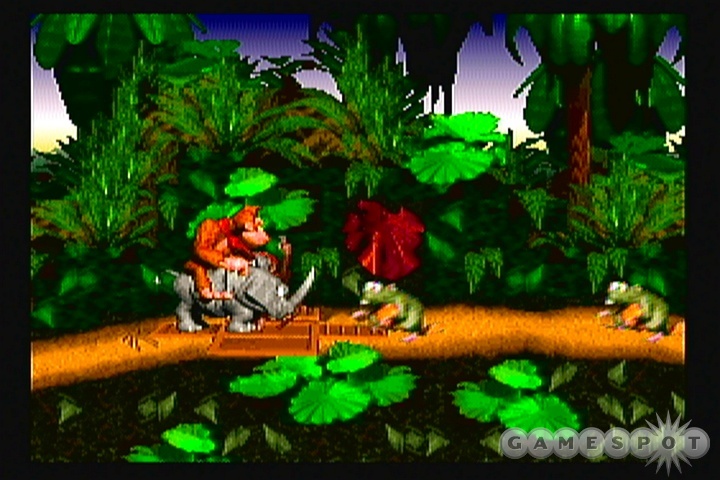Back in 1994, Nintendo was busy trying to convince people that the 16-bit Super Nintendo Entertainment System still had life left in it. The company's argument was that games on the Super NES could output graphics on par with what the forthcoming 32-bit consoles were capable of. To prove it, they teamed up with Rare to produce Donkey Kong Country, a Mario-style platformer that featured backgrounds and characters that were initially modeled in 3D on powerful Silicon Graphics hardware and then transformed into 2D objects for use in the game. Those snazzy tropical graphics, along with the game's solid platforming chops, did indeed convince people that the Super NES wasn't dead yet, to the tune of more than 8 million copies sold. Now that Donkey Kong Country is available for the Wii's Virtual Console, more than a decade after its initial release, it's incredible to see that time hasn't done much to diminish how fun the game is.

In gameplay terms, Donkey Kong Country is a side-scrolling platformer. Using DK and Diddy, you have to run, jump, and swing your way through 39 levels filled with lengthy jump sequences and hazardous enemies. DK and Diddy can dispatch enemies by rolling through them, pouncing on them, or by tossing barrels at them. Each character has his unique strengths. DK can dispatch larger enemies that Diddy merely bounces off of, while Diddy can jump a little higher than his bulky cousin. It isn't the most original blueprint, but it works. The different things you can do in each level help keep the journey lively. Each stage has its own theme, whether it's swimming underwater, riding in mine carts, swinging from vines, or launching your character out of barrel-cannons. There are secret passageways that lead to bonus games where you can earn bananas and balloons, which ultimately translate into additional lives. In many places, you'll find crates that contain animals that you can ride and control--anything from a rampaging rhino and a bouncing frog to a swimming swordfish and a flying ostrich.
When Donkey Kong Country was first released, people were impressed by its prerendered graphics and intricate soundtrack. What's really impressive is that those aspects have withstood the passage of time. The characters are fluidly animated and have loads of personality. The tropical environments are rich with color and make use of every visual effect in the Super NES's arsenal, including rain, mist, and day-to-night transitions. Some stages take place beneath the surface of lakes and swamps, where a bubbly translucency effect suggests the presence of water all around you. Even though the game is a side-scroller, it often conveys a three-dimensional sense of depth, because everything was modeled in 3D before being transformed into 2D sprites and background layers. They didn't skimp with the audio, either. DK and Diddy actually sound like apes, and the other animals make realistic grunting and hissing noises, because the majority of sound effects were made using actual recordings of real animals. The soundtrack has a tropical feel and is a joy to hear, thanks to some melodic synthesizer work and the use of real instrument samples.

For the most part, the Virtual Console emulates the game without a hitch. If you play on a large high-definition set, you may notice the rough outlines surrounding the characters and some background objects. Considering how nice the graphics are otherwise, it's not a big problem. On a standard-definition set, interlacing tends to soften and hide those rough edges. Something else to keep in mind is that this version of the game doesn't have any of the extras that were included in the later Game Boy Color and Game Boy Advance ports. That means there aren't any minigames or time-attack challenges. Of course, it also means that the graphics and audio haven't been scaled back to suit the limitations of the GBC and GBA.
Along with Super Mario World, Donkey Kong Country is one of the Super NES's defining platformers. Nintendo and Rare went to great lengths to break new ground with it in 1994, and that effort is a good reason why the game has aged so gracefully. The graphics and audio haven't lost their appeal in the years since, and the platforming, while straightforward, is still very addictive.